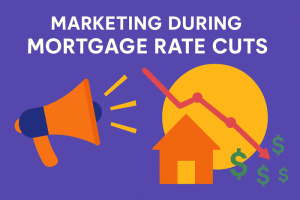Summary
This article covers marketing strategies specifically for loan officers, providing tips and techniques for engaging with clients and growing business. Learn about leveraging digital tools, building relationships, and creating effective campaigns. By the end, you’ll know how to implement marketing strategies that work for loan officers.
Here are four of our favorite marketing tasks that every loan officer needs to have in their 2020 marketing plans. Or click here to learn how to get the most out of your marketing budget in 2020.
1. Make Your Content Stick With Keyword Research

Anyone can make content but the best way to ensure the content you are creating is great for your potential clients is by performing keyword research. Using tools such as Google’s Keyword Planner (Free tool), Ahref’s Keyword Explorer, or SEM Rush will give you the ability to examine the relevance of topics you are considering writing about. It’ll actually show you how many people are searching for and looking for information on any topic you’re thinking of making content about.
Start with a little research on your past client database and dive further into the niches you have discovered by actually reaching out to your past clients. They know and like you so they will be happy to help you. Ask them questions about fears, concerns, and uncertainties they had about the home loan process before they came into contact with you. Ask them if they performed any web searches. Ask them what types of things they were searching that brought them to you.
Based on this research, create a list of potential search terms your ideal customers might be typing into Google and do research on those terms. Throw out the ones with little or no search traffic and come up with article topic ideas that will support the search terms that are the most popular.
Creating and promoting your content isn’t cheap, the goal here is to make sure that every piece of content you create already has an audience that is looking for and willing to consume it.
2. Post On The Right Platform

When choosing how you approach Social Media it’s important to remember two things. First, remember that each platform is built with a different contextual framework. Secondly, remember that your buyer personas (ideal clients) hang out in different places online. To do social media effectively, you need to know where your ideal potential clients are hanging out and how to maximize your exposure on that platform.
Here are things to consider regarding the contextual framework of each platform:
LinkedIn, while a social media platform, leans towards business. For this reason, the content you promote on LinkedIn should be more detail-rich data that breaks down the nuts and bolts of how to do something or statistical analysis of the market at large.
While you can post links to your blog directly onto LinkedIn, the organic reach through taking that content and creating an article on LinkedIn will help you greatly.
PRO TIP: All social media platforms will boost your content if you share on them natively. If you have an article don’t just share the link, create the article on LinkedIn or share important snippets on Facebook. If you have a video, don’t just post the Youtube link, upload the video file directly to social. These platforms don’t want their users leaving the platform so they will actually boost content that is posted natively.
Unlike other social media platforms, you cannot post links in Instagram posts. So posting about a blog article isn’t an effective use of this platform. If your image is compelling enough to stop people in their tracks though, you can write a rather detailed synopsis of your article that will intrigue the reader to want to find out more. You can even make a graphic featuring a snippet from your article and post it. The best practice in closing a post such as this is by writing, “To read more, go to my blog. Link in profile description”. (Of course, then you want to make sure a link to your blog is listed in your profile.
Client success stories are also perfect for Instagram. You can post a photo of your clients in front of their new home for instance. In the text of the posting, you can tell a brief story about what your client needed and how you knocked it out of the park for them. Or, even better, record a video testimonial of them saying what a great job you did and post that on Instagram as your social post.
Facebook is sort of a jack of all trades when it comes to social media. On this platform, you want to experiment with posts linking to your blog articles, video of you describing the articles and even proof of production videos. If you aren’t comfortable with social media, this is probably the best place to start because the chances of you doing something wrong are pretty low as their platform is pretty flexible.
Twitter is a micro-blogging platform, so you have to be very concise. The best use of twitter is promoting your blog content, but it requires thought. You have to come up with a short (280 characters including your link) sentence about why your article is so great and then post a link that will take the reader directly to your article.
PRO TIP: In order to stay under the 280 character limit, it is best you use a service like bitly.com to shorten your blog link.
3. Using Video To Promote Your Content

Video is massively important to the promotion of your content. According to Biteable.com, 81% of businesses use video as a marketing tool. This is not a trend or by chance. They are doing this because 6 out of 10 consumers say they would rather watch video content online than on television. In fact, roughly the same percentage of people say they would rather watch video content than read things online. Because of this, video presents a huge opportunity.
Using video to hedge your bets, you can re-purpose written content that you see performing well to nab those that may not take the time to read a written blog article. You can also use video to summarize long-form content you’ve written in the hopes of intriguing potential clients and getting them to click through to your website and actually take the time to read it.
Video summaries will almost always be more effective than written summaries. Take out your phone and record a 30 second summary of what your content is about and why it’ll benefit them. Post that video to social with the link and even a written summary (now you’re covering all your bases)
To put it simply, video will help you drive engagement and that extra engagement will do wonders in driving up the number of people that are interacting with and viewing your content. Essentially the key is to create mini content to promote your content.
4. Sponsor A Local Event

This final marketing task, unlike the other three described above, is offline marketing. At the end of the day, the fastest way to build long-lasting and authentic relationships is to be face to face with people and have a personal relationship with them. The single easiest way to do this is to get involved in the community.
Remember, for many people, buying a home is the most expensive investment they will ever make. Not only that, given the fact that this is going to be a home for their family, it is a very emotional transaction. Being the face of a community and familiar to those that are in need of the services you provide goes a great distance towards building rapport and solidifying in people’s minds who you are and what you are all about.
Let’s say for instance your local community has an annual art and wine festival. Getting involved with this event is a great way to promote your mortgage brokerage. With relatively few dollars out of your marketing budget, you can either sponsor a booth where you can talk with potential clients about their mortgage needs. You can also become a logo sponsor of the event, where you pay a fee to have your logo put on all signage and promotional materials for the event itself.
If you are a logo sponsor for the event, inquire as to whether it would be possible for you to even spend some hours manning a booth serving wine. This would give you the opportunity to get to know the organizers and other volunteers, as well as have valuable interaction with people that live in the community that are attending the event.
One important thing to note here is that if you are going to participate in community events, you have to actually participate. Simply cutting a check and sending it into an organization that needs money will certainly be appreciated, but it won’t do anything to help you grow your mortgage business. Invest in the organization and it will show people you meet in the process that you are invested in your community. People want to do business with people that are passionate about the same things they are.
Four Steps To Success
The truth is there are many, many marketing tasks required to continually grow your mortgage business. These four though are a few that your competition is likely not utilizing. If done correctly, they’ll give you a leg up and allow you to really get all of your marketing efforts lifted to the next level.
Key Takeaways
- Effective Marketing Strategies
Learn strategies tailored for loan officers to help them engage clients and grow their business.
- Relationship Building
Building strong client relationships is a key focus in these strategies, leading to long-term success.
- Digital Tools
The article highlights digital marketing tools that can streamline the process and help loan officers connect with potential clients.
Commonly Asked Questions
- What marketing strategies are recommended for loan officers?
Strategies include relationship building, using digital tools, and creating targeted marketing campaigns.
- How can loan officers build strong relationships with clients?
By offering personalized service and maintaining consistent communication with clients.
- What digital tools are discussed in the article?
The article emphasizes the importance of leveraging digital marketing tools to reach a wider audience and streamline marketing efforts.
- What is the main goal of the article?
The goal is to help loan officers develop marketing strategies that enhance client engagement and business growth.





